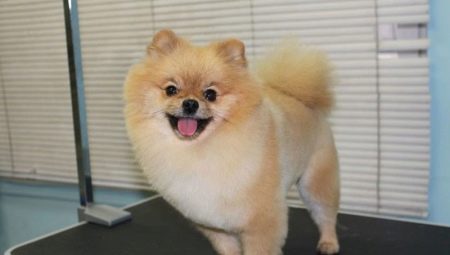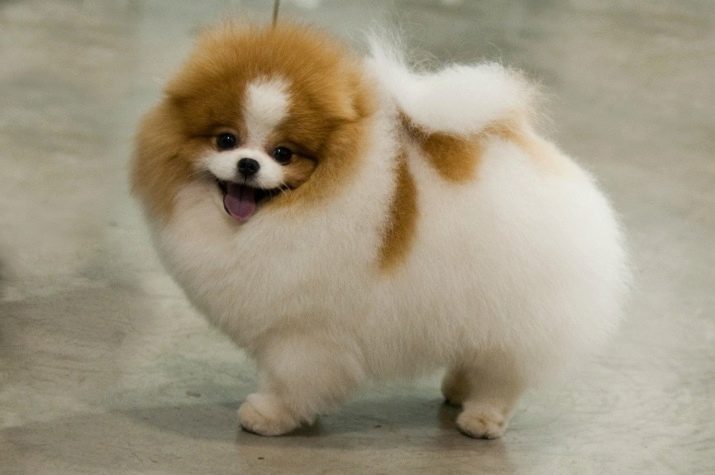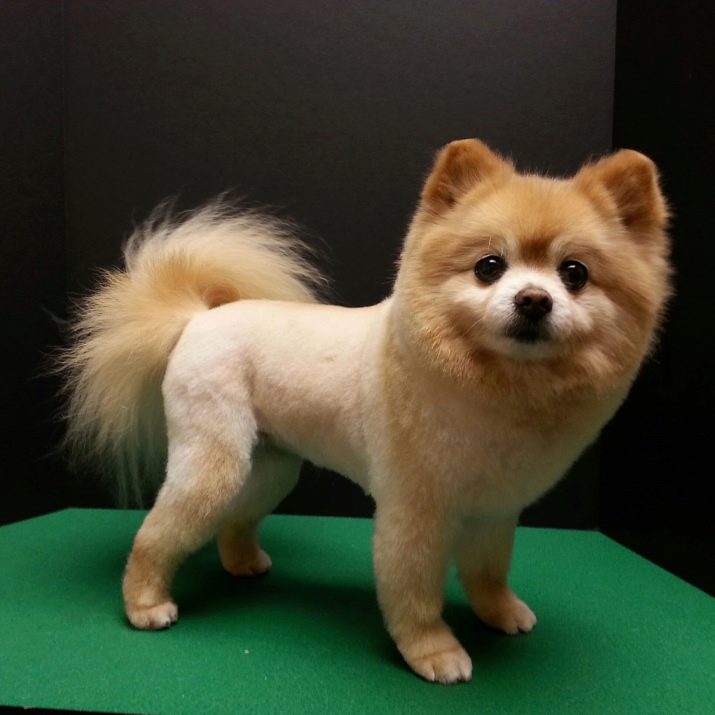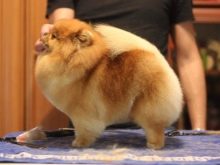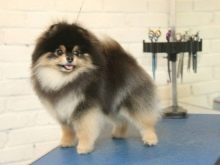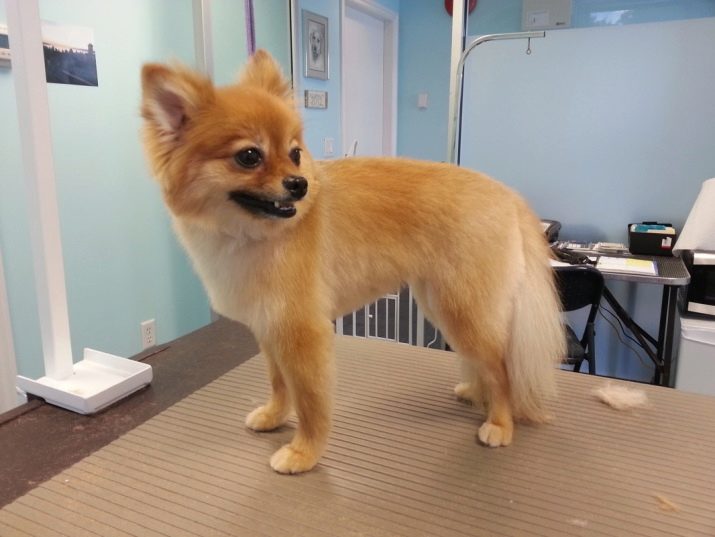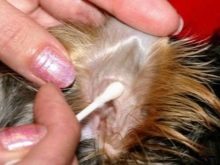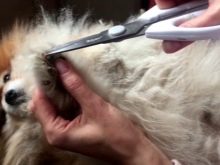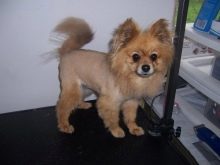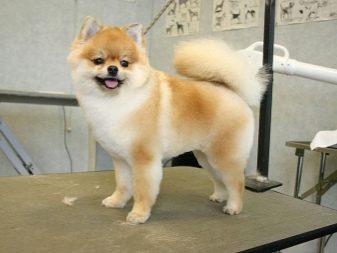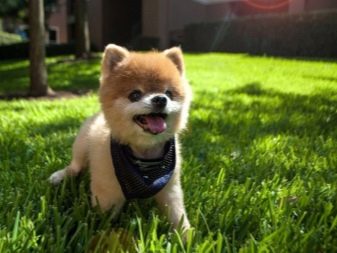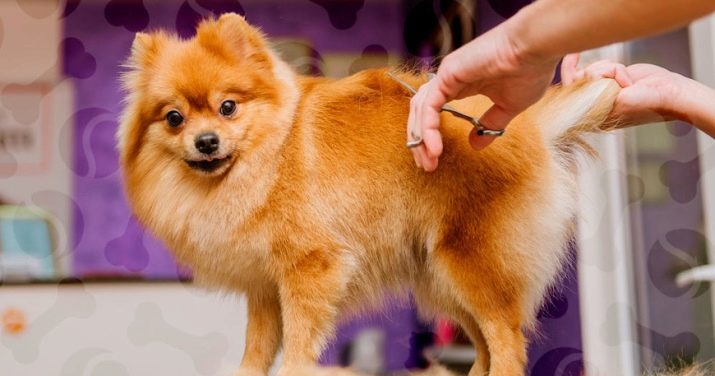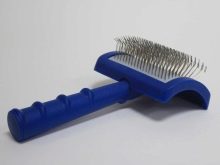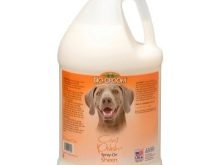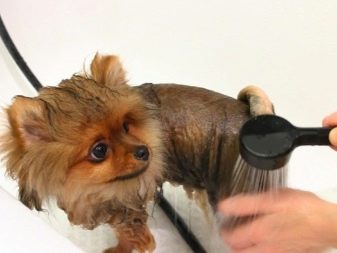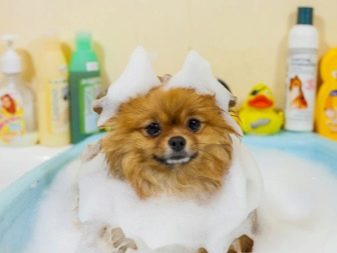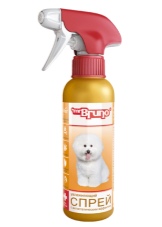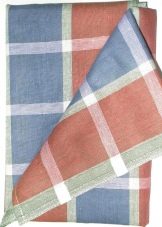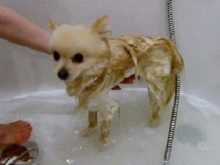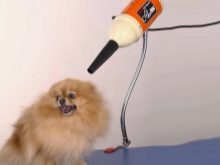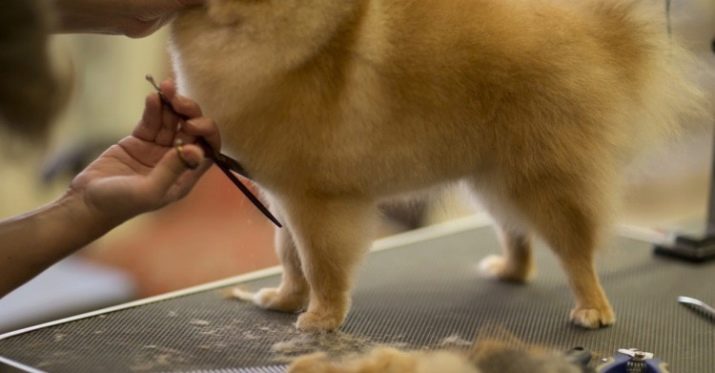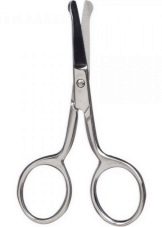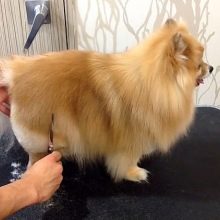Spitz has a long and surprisingly beautiful hair, for which you need a delicate and regular care. One of its elements is a regular haircut. This article will look at how and when you need to cut Spitz and whether to even do a haircut.
When to cut and how often?
Immediately it should be said that experienced breeders do not advise grooming these pets. It is allowed only in situations, some of which are described below.
- Regrown hair. The long hair clearly prevents the animal from running and playing quietly. This is especially true for short-faced Spitzers, whose hair is so long that it can impede movement.
- Mud. After numerous walks, the animal's hair was very felted, thick and dirty mats were formed, which cannot be removed with a comb or washed off.
- Temperature threshold. With the onset of the warm season (early spring, summer), the spitz with their lush fur coat can be extremely uncomfortable to be under the sun. Due to the great gravity of the coat, the dog quickly gets tired and suffocates.
- Diseases. Haircut is recommended in cases where the wool has become a haven for harmful insects or bacteria that can not be washed off with plain water. In addition, in a long coat often accumulates a large amount of dust and dirt, which can cause inflammatory or allergic processes on the skin.
- Moult. During periods of molting, young spitz throw off a huge amount of wool. Usually these processes begin to occur already from the age of three months. Some owners prefer to simply cut Spitz shortly so as not to engage in constant cleaning.
It is not recommended to cut Spitz for some reason.
- Protection. Hair coat for Spitz dogs, and especially for young individuals, is like a life jacket that protects them from frost, temperature fluctuations and annoying insects. If you cut off this cover, the spitz is extremely vulnerable to colds.
- The statement that the spitz need a haircut before the summer season can be controversial. In dogs, perspiration is not the same as in humans — not through the skin. With the heat, they prefer to fight through their tongue hanging out.
The fact is that any solid haircut can expose the thin and delicate skin of a dog, which, if exposed to direct sunlight, can cause serious skin diseases.
- Attempts to "cheat molt", when right during this process the hosts simply cut the entire upper hairline, they are fraught with the same consequences. And against molting, and against the summer heat can be fought and in another way - constantly comb your dog, using both an ordinary comb and a puhoherka.
- Mental condition. Any haircut causes attacks of fear and aggression in Spitz, consider such a procedure a huge blow to the psyche of the animal, especially for abdominal hairstyle.
In addition, trimmed Spitz in the society of their relatives can become an outcast due to the lack of a full-fledged coat.
On some resources you can find information about when exactly you need to keep your pet on the very first haircut. However, from the above, you should have already understood that This procedure should be carried out only when absolutely necessary.. The same applies to the regularity of the Spitz cut haircuts - if we take into account situations in which grooming of these dogs is really necessary, then you will have to take dogs to a groomer no more than 2-3 times a year.
Grooming allows you to make the dog's hair shorter, forms beautiful hairstyles, while not touching the undercoat, which performs a protective function.
Types of haircuts
Not so long ago, a beautifully trimmed spitz was a must-have “attribute” to any self-respecting lady at social events in Germany and the USA. These dogs had long hair, which allowed to create amazing hairstyles.
- Under boo. It is considered a very fashionable and successful haircut for dwarf Spitz breeds. Animals shorn in this way can often be found on social networks - they become heroes of jokes and different stories. In this hairstyle, the main emphasis is on the most miniature and plush body with uniform legs and a large round head with small, slightly protruding ears. With all of its appearance, such a spitz resembles a little bear that ran out of the woods. Small black bear eyes and a small miniature nose give an ironic look to the image.
Despite the incredibly cute appearance, so cutting pets is not recommended - dwarf spitz even with long thick hair have a rather fragile and capricious health, not to mention the complete absence of wool.
- Short or homemade haircut. It is the simplest type of haircut, as it does not require any additional tasks from the owner. A certain layer of wool is simply removed from the pet, leaving no more than 3-5 cm with the undercoat.
- Hygienic haircut. A simple haircut, but requiring regular care from the owner to maintain a well-groomed look.
Some preventive procedures are also included: cleaning the ears, washing the eyes, and cutting the nails.
- Under the lion. It is the most controversial type of haircut, as in this case the hair is removed so carefully that it is practically not restored in the future. Haircut involves the complete shaving of the hair on the spitz from the muzzle down to the shoulder blades. On the head, the top of the head, the back of the head and the breast, and also on the tips of the paws and tail, the hair remains, forming a peculiar mane and the likeness of a lion's exterior.
This type of haircut is ideal for individuals whose hair does not grow on certain areas of the body.
How to choose?
The choice of haircut for spitz depends on several factors. They are distinguished by experienced breeders who lead their spitz to various competitions, exhibitions and public receptions.
- purpose. If you are cutting your spitz solely for practical purposes, then you should choose the most simple haircuts that will not interfere with the animal itself and will not require adjustments soon. If your goal is an exhibition, then you should think about some extravagant hair style.
- Place of residence of the pet. For homemade Spitz, who spend most of their time at home, there is no point in choosing some intricate haircuts. There is also no need to particularly follow the length of the scalp - after all, at home it is very difficult to catch a cold. If your pomeranian is constantly on the street, participates in competitions or exhibitions, then it is worth picking up at the same time an unusual, but also warm haircut that will not allow him to get sick or injure his skin.
- A type of spitz. On some breeds, for example, on the German Wolfspitz, extravagant hairstyles will look ridiculous - this is a guard breed of dogs that rarely participates in any competitions. You should also think about the breed of the animal and imagine whether the hairstyle will contrast with this look.
- The color of the animal. Some types of haircuts look good only on animals with a certain shade of wool.For example, haircuts under Lev will look great only with representatives of Spitz red and fiery colors. But a haircut under Boo will look great with white and black individuals. You should also pay attention to the color of the undercoat of the animal - it can greatly affect the overall image of the spitz after shearing.
How to do?
Most often, a professional haircut, or grooming, is carried out in specialized salons by craftsmen, but even an inexperienced breeder can cope with the simplest hygienic haircut at home. Those who just started a dog and have no idea about grooming pets should still go to the salon for the very first time and just watch the grooming process.
The secret of cutting any spitz is that it is carried out in three stages: combing, bathing, cutting itself.
Preparation involves the initial treatment of the animal's hair. To this stage was as calm as possible and did not cause an excessive panic in your pet, try to follow the rules described below.
- Hair should always be combed against the growth of hair, that is, from the tail to the top. In this case, you can get to the bottom layers and undercoat, which often formed mats.
- Buy a soft, durable wooden brush with thin and frequent teeth in advance. Make sure that the comb or brush is delicate to the hair - it should not pull or break them.
- Do not overdo the combing time. For proper preparation, 10-15 minutes of quiet work are often enough. Try not to touch the undercoat with a brush, so as not to deprive the pet's fur coat of natural fluff.
- Since any careful combing is dangerous to the skin, try to choose a comb with a gentle and rounded teeth. If wounds or scratches form on the animal's skin, it is likely that they fester, turn red and can cause, if not inflammation, then an ordinary dog discomfort.
- Be sure to remove all mats and knots in the wool. For comfortable and quick removal, you can use a special spray.
- For all procedures haircut should choose a specific place where the pet would feel as safe as possible. If you are going to cut a puppy, then it is better to keep it in your hands during the procedure - so he will rather get used to it, that there is nothing terrible in these actions and will be calmer in your arms.
After preparation and scratching proceed to bathing. Just like a haircut, it should be done extremely rarely and at discretion - no more than 2 times in six months. If after a walk at your pet's paws or ass are dirty - rinse only certain parts of the body, without touching the main coat.
It is not necessary to bathe your pet right during the molt, during this period the wool is weakened and can simply pile up.
List of tools that you may need for carrying out water procedures.
- First of all, special shampoos on a liquid or dry basis, as well as conditioners for spitz with a thick undercoat.
- Antistatic - useful to you at the time of hair cutting. Because of their long length, Spitz hairs often become electrified and can cause electrical discharges that will harm you or the animal itself.
- Powder or bleach, special shampoo for blond hair, designed to return the natural color.
- Ordinary nap or linen towel, which you do not mind.
- Spitz has a rather long hair and thick undercoat that dries slowly and difficult. That is why you also need a hairdryer.
Bathing procedure itself also takes place in 3 stages.
- Training. At this stage, plug the dog's ears with a cotton swab (to avoid water), then put the dog in the bathroom. The first step is to thoroughly wash the pet's hair with plain water, having chosen the appropriate temperature in advance.Try not to touch the head and top of the head while doing so.
- Water treatments. After you wet the pet's entire body, apply a little shampoo on a sponge or cloth and apply it evenly over the entire length of your hair with smooth movements. Then, with your fingers, fool it a little and make sure that there are no tangles.
- Drying. After waiting literally half a minute, start slowly rinse the shampoo under running water, apply conditioner, rinse all wool thoroughly again. After the procedure, it is worth wiping the pet with a towel and then using a hairdryer. Do not trust the drying of the spitz itself - they will dry on their own for a very long time.
In the process of drying, follow these rules.
- At the very beginning, adjust the hair dryer to a comfortable temperature for your pet.
- Use a large comb with frequent teeth to raise hair against their growth. For the formation of hairstyles and hair drying help hairbrush hair dryer.
- First dry the undercoat itself, and then the areas of the raised hair.
- You should not hold the hair dryer in one place for a long time and in no case should you bring it close to the skin. The drying process with a hairdryer should be carried out very quickly - in just a couple of minutes.
- After drying, once again comb the pet, but already along the hairline - to check the purity of the wool and prepare it for the haircut itself.
For cutting Spitz use only scissors and other available tools. No electronic tools like typewriters or trimmers are usually used here - with the help of them it is more difficult to monitor the smoothness of transitions and length.
Tools that may be useful to you in the process of cutting (most of them can be found at home):
- small sharp scissors - to reach hard-to-reach areas;
- blunt scissors - for work near the undercoat and delicate skin;
- thinning scissors - useful for thinning the thickest areas of fur on the chest, crown and abdomen;
- a few hairbrushes with different length and different texture of teeth;
- also grab a massage brush - it can be useful for effective combing hair and calm the animal.
In the process of cutting a pomeranian, you should move consistently, working alternately with different parts of the body.
Below will be described step by step scheme of cutting a conventional spitz. Remember that the sequence of processing wool may vary depending on the type of haircut.
- Ears. Identify the edge of the animal's ears and pinch it between your fingers. Outstanding hair should be carefully cut to the desired length. On the ears themselves hair rarely grows, so they should not be touched.
- Collar. Grooming masters usually choose a circular method of cutting the head. In this case, the front hair is aligned with a comb down, and behind it is simply combed against the growth line on the back of the head. After you have visually imagined the size of the so-called “mane”, you should pinch the necessary piece of wool with your fingers and gently walk with ordinary scissors around the back of the head to the top. Try to correctly choose the length of the haircut, so that a correct semicircle will form on the back of the head. To continue the circle should set the correct length of the hairstyle for the chest and chin. As a result, you should have an almost perfect circle, starting from the chest to the top of the head and the neck.
- Rear part. Since most Spitz breeds like to push the tail to the anus, it should be lifted and placed on the back of the animal. After that, gently comb the hair along the hairline in different directions. Here it is worth cutting only the biggest hairs that can really interfere with the pet. Before the procedure, it is recommended to determine for the pet the borders of the back, along which you will move during the haircut. Care must be taken to ensure that the length of hair near the anus coincides with the future length of the rest of the hair.For a haircut in this area it is better to choose scissors with blunt or rounded teeth.
- Tail. In order to trim the tail correctly, you must first carefully comb it along the hairline and place it on the back of the animal. Then divide it into two parts - left and right, and remove the longest and protruding fur on both sides with scissors. As a result, should get a flat, but fluffy and luxurious tail.
- Limbs and legs. Wool on paws in the same way is smoothed and combed, special attention should be paid to wool between the pads. For this you need to use small scissors with blunt tips.
- Since after such procedures your spitz may look unnaturally round or even sharp, take advantage of ordinary thinning scissors to make the whole wool look tidier and more natural.
On how to cut a spitz, see the following video.
